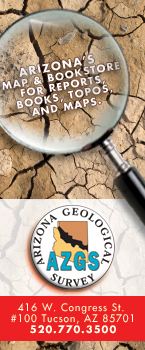Michael Conway - editor; Arnie Bermudez - videographer
On 22 November 2013, we interviewed Dr. Spencer Titley, Professor of Geosciences Emeritus, Department of Geosciences, University of Arizona, on the history of porphyry copper exploration in Arizona. The videotaped interviewed took place in Dr. Titley’s rock lab on the 5th floor of the University of Arizona’s Gould-Simpson Building.
A pioneer in porphyry copper exploration, Dr. Titley’s career includes work as an exploration and mining geologist in the mineral industry and as a professor of geosciences. In 2009, he was honored for 50 years of teaching and service to the University of Arizona’s Department of Geosciences. During his tenure, he was the major advisor for 135 masters and doctoral students. While formally retiring in 2009, Dr. Titley continues to teach courses in basic and advanced mineral deposits, mineral resources and societal relevance, as well as on-demand courses in regional settings of ores, hydrothermal alteration, and in ore and alteration microscopy.
 Video: The Geologic Framework of Arizona
Video: The Geologic Framework of Arizona
From Dr. Titley’s description of his work, “My research has had a concentration on those aspects of regional geology, geochemistry and isotope studies that lead to an enhanced understanding of the time and place of metal concentrations. Whereas much of my work has been on porphyry metal systems (Cu-Mo-Au), I have also studied and reported on the geology of different ores across the hydrothermal spectrum, ranging into precious metal epithermal ores of Mexico and New Guinea. My principal focus of activities in these fields is generating scientific information that may be applied to the actual problems of discovery of ores and their development as mines. My geographic focus has been the Pacific Rim and I have taught numerous short courses for industrial and academic persons on Porphyry Copper Genesis and Exploration in Chile, Australia, the Philippines, and New Guinea, as well as the United States.”
Can you trace the roots of geologic investigations comprising the framework of Arizona geology?
An important history and relevant to our study of ores -- as well as a subject of emphasis with my students – is that the geologic framework of most of southern and central Arizona was built by US Geological Survey geologists, who in great part were studying mining districts. They were not mining geologists, they were “general” geologists in an era before a specialty in the study of ores evolved who put the stratigraphy together, put the paleontology together, and put the structural geology together in a framework that survives with us today. They established this necessary framework during pioneer times a hundred years ago.
They worked all day long; writing their notes at night according to B.S. Butler with whom I studied when I first came here. They would send their notebooks back to Washington D.C. where they were transcribed by secretaries and became professional papers. And we still use those US Geological Survey professional papers as references today.
Arizona’s porphyry copper deposits form the foundation of the modern mining economy here in AZ. You and your students have worked in and around these deposits for half a century. Can you draw out a general picture of what we know and don’t know about porphyry copper deposits?
I can describe the evolution of porphyry copper systems as we see them now. The development of porphyry copper systems, and it’s interesting to start with the oldest ones, probably begins in the Globe Miami district and Silver Bell, among others. [Ed. note: Silver Bell is a porphyry copper mine in the Silver Bell Mountains of Pima County, Arizona. Operations began in the 1870s and through a long convoluted history continues today.] They (mining companies) started mining very thick, very rich veins of copper and copper oxides, chrysocolla [Ed. note: chrysocolla is a hydrated copper silicate]. And this gave way ultimately to mining the enriched sulfide ores, chalcocite (Cu2S). And they started milling chalcocite that we are still mining today at Ray for example: this is “enriched naturally ore” mined down into very low grade ores of two-tenths of a percent or so. And they have gone back now to extracting and taking the top off these deposits and looking deeper, and we are now back mining chrysocolla of very low grade - where we started mining. So we have come full circle on the chrysocolla.
I arrived here as a graduate student in 1955. And this was right after the discovery of the Pima Mine. The Pima Mine really starts a generation of discovery and lots of geologic work. Pima was the first mine discovered under cover, it was “blind.” There were two men who really started this expansion of discovery, Walter Heinrichs who is now gone and Robert Thurmond. [Ed. note: Walter E. Heinrichs, Jr., passed away on 21 October 2013.] They put a magnetometer (actually an airborne submarine detector, developed during WWII) on the back of a Dodge Power Wagon and then drove across the country and found an appropriate geophysical signature, which was that of the buried Pima Mine. The result of this discovery was 25 or 30 years of very intense exploration across this region with geophysics and geologic work. Probably 1000s of miles of geophysical lines were run out over cover looking for buried and blind deposits. To me, Heinrichs’ work at Pima really started a very significant chapter and changed our way of thinking about where the deposits were, where we should look, and gave rise to reasonable expectations of success – if we use the right tools. So I view that discovery as the beginning of modern porphyry copper exploration. The drive to discover and develop copper resources began during WWII when the government, with consulting and survey geologists began intensive exploration of some long recognized districts in Arizona, a conspicuous example of which might be the ore body at Ajo and the discovery, and recognition of, the – exposed - San Manuel ores as a porphyry copper system in about 1950.







